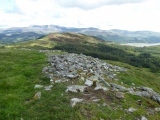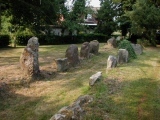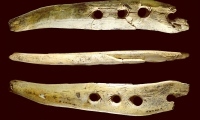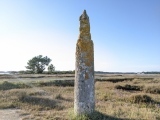Andy Burnham's Blog, page 190
August 8, 2020
Stone Cross Konstantinovy Lázně
One of the biggest medieval stone crosses in south-west Bohemia can be found in the park of the spa town of Konstantinovy Lázně.This 160 cm tall monument is made of hard sandstone and has several distinctive reliefs of a Greek cross in a circle. The only thing clear is that the cross was displaced sometimes after WWII. Its place of origin was in the middle of the fields behind nearby Bezdruice village.
Published on August 08, 2020 14:05
August 6, 2020
Bryn Castell Hillfort
Bryn Castell hillfort in Gwynedd was possibly intended as a temporary refuge for a small group of people comparable with Craig Y Castell and Craig y Dinas. It consists of a just a single wall enclosing an oval area of about 1/4 acre. The enclosure wall is now very low and eroded but there are traces of internal and external facing and the naturally defensive steep slopes of the hill on all sides gave the fort a strong position. There is evidence of one internal structure at the northern end.
Published on August 06, 2020 14:32
August 5, 2020
Hünengrab Wechte (1)
Published on August 05, 2020 14:34
August 2, 2020
Cefn Clawdd near Ffridd Lwyd
A prominent and well preserved ring cairn in a remote location in Gwynedd. Thought to be early Bronze Age (2000 - 1500 BC). A circular bank of large stones. 15 feet in diameter. With a central stone lined cist that held the body or ashes of those interred.
Published on August 02, 2020 10:34
Summstein Holthausen
The Summstein ("Humming Stone") is a modern basalt stone sculpture situated in the modern main cemetery in Mülheim an der Ruhr, North Rhine-Westphalia, Germany. The stone carries the inscriptions of the names of the people that have been buried in this part of the cemetery wood without further grave markings. Another standing stone has been erected close by, possibly as a future second Summstein.
Published on August 02, 2020 10:34
Hohlefels Höhle
Archaeologists discover the oldest tool used to manufacture twine (probably), see the comments on our page for this and many more discoveries from Hohle Fels Cave. Cave in the Ach Valley near Schelklingen, Swabian Alb, southern Germany. It has yielded a number of important archaeological finds dating to the Upper Paleolithic. Artifacts found in the cave represent some of the earliest examples of prehistoric art, tools and musical instruments ever discovered.
Published on August 02, 2020 01:50
August 1, 2020
Towtop Kirk
An irregular circular-shaped enclosure in Cumbria approximately 40m in diameter which is surrounded by a low turf-covered bank of piled small stones up to 3.5m wide and 0.7m high. Earlier interpretations had suggested a Bronze Age stone circle or enclosure but this does not on balance seem likely - although it must be stressed that very early Christian sites often occupied previous Pagan sites to convert the inhabitants - Towtop may have been selected for its prior use as a sacred gathering site. The geography certainly favours a prior Pagan association.
Published on August 01, 2020 06:07
July 31, 2020
West Woods Sarsen Stones
Multidisciplinary analysis of the sarsen stones at Stonehenge and samples from 20 sites across Southern England confirm the vast majority of the sarsen stones came from West Woods on the Marlborough Downs, 25km north of Stonehenge. Our page shows the approximate location, and find more details in the comments. Likely source of the sarsen stones of Stonehenge. West Woods lies within a concentration of Early Neolithic activity, being close to Avebury, numerous long barrows, and the causewayed enclosure at Knap Hill (see nearby sites list). Evidence of Mesolithic through Iron Age occupation has been recorded in the area, including a 40m-long Early Neolithic chambered long barrow, sarsen standing stones, a sarsen polissoir used to sharpen stone axes, and prehistoric fields where now-wooded ground was previously open, cultivated land.
Published on July 31, 2020 10:03
July 30, 2020
West Woods Long Barrow
Long Barrow in Wiltshire. An oval barrow with flanking ditches. A burial chamber was found somewhere within the mound in 1880, apparently enclosing an inner ring of sarsens. Access: Situated about 600 metres from the road, the lane is a Byway so is easy to walk. Opposite a small quarry is a foot path, follow this keeping an eye to the left - the barrow is in the woods, be careful.
Published on July 30, 2020 15:26
July 29, 2020
Kegil Berhed
An Iron Age stele or lec'h which was Christianized in early modern times, possibly at the time of the construction of the nearby Chapel of St. Brigitte in Plec in the 17th century. The stèle is situated on the narrow neck of marshy land between two of the main channels of the Etel river. It consists of three parts; the original column, which is about 2.7 meters tall, a carving of the crucifixion, and finally a conical crown on top.
Published on July 29, 2020 06:49













